Join our 1-year-old giraffe calf, BB, and her keeper team for two behind-the-scenes training sessions. Our youngest giraffe is working on voluntary husbandry behaviors that allow her team to take the best possible care of her. Watch as BB follows cues and gets positive reinforcement for participating in injection training and voluntary hoof care. Way to go, BB!
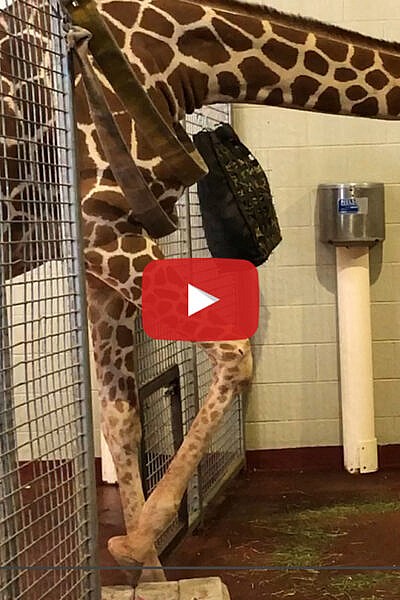

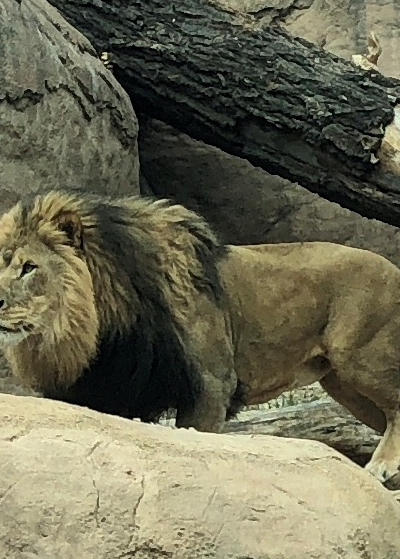

 In the wild, animals spend a lot of time and energy foraging or hunting for food. Feeding our animals seems like a pretty fundamental task of animal care, but it’s more complicated than one might think. Just like our partners at Children’s Hospital Colorado talk about foods that can have calming effects for kids, we work to present our animals’ special diets in ways that nourish their bodies and support their natural instincts.
In the wild, animals spend a lot of time and energy foraging or hunting for food. Feeding our animals seems like a pretty fundamental task of animal care, but it’s more complicated than one might think. Just like our partners at Children’s Hospital Colorado talk about foods that can have calming effects for kids, we work to present our animals’ special diets in ways that nourish their bodies and support their natural instincts.
Wild animals have to solve problems and exert physical energy to feed themselves, which is good for their physical fitness and their mental well-being. Here at the Zoo, we provide opportunities for our animals to fulfill their instinctive hunting or foraging behaviors by hanging food high, or burying it, or placing it in a puzzle feeder that requires focus and dexterity to reach.
“We work hard to create environments and provide daily activities that enrich our animals’ lives, but some people might not immediately recognize that their meals are another opportunity for enrichment,” said Rachael Hahn, lead keeper in African Rift Valley. “I get to work with one of the most iconic hunting species out there: African lions. In the wild and in human care, African lions typically sleep 20 to 22 hours a day, but when they’re active, they’re certainly making up for lost time. They’re unbelievably smart, incredibly strong and as confident as they come.”

Hahn and her team in African Rift Valley make meal time mentally and physically stimulating for Abuto, the 10-year-old pride patriarch; Lomela, 14-year-old matriarch; Elsa, their 6-year-old daughter; and Boma and Aslan, their 6-year-old sons. In addition to scattering food throughout their large yard, the team hangs big pieces of meat up high in a tree for our African lions, so they have to climb up and drag it down, like they would do with some prey in the wild.
“We have been doing this for a couple of years where guests can see it, and the lions seem to really enjoy working for their rewards,” said Hahn. “We also put meat inside some of their giant plastic boomer balls, and have seen the lions ‘playing’ more often, even when food isn’t involved. I’ve seen Lomela, who’s nearly 15, playing with toys like she’s a kitten again. Since making this addition to their routine, we’ve seen them exhibiting calmer behaviors at other times of the day, which is a great indication that they’re mentally fulfilled thanks to these additional opportunities to solve problems.”
Water’s Edge: Africa keepers provide meal-driven enrichment opportunities for the high-energy, intelligent residents of Lemur Island, too. The ring-tailed lemurs at CMZoo get the chance to frequently dine-and-dash, because their meals encourage them to, and the family’s diets are rarely presented in the same way.

“Lemurs are one of few primate species that forage from the ground, up high in the trees, and everywhere in between,” said Al Carrier, Water’s Edge: Africa keeper. “They’re super smart, so we get creative finding new places to stash their food. It’s kind of like an Easter egg hunt every time we place their meals on Lemur Island for them, and it’s fun to watch them scurry and leap around, finding their delicious rewards.”
Keepers also use puzzle feeders that the lemurs can use their long fingers and impressive fine motor skills to retrieve food from. They hang food in spheres that require the lemurs to stretch, climb and leap to reach. They also get seasonal delicacies, like browse.
“In the wild, lemurs eat tree leaves and buds, so we provide that as often as possible for our lemurs,” said Carrier. “We bring in fresh browse – otherwise known as tree branches – from our community and sometimes from our shipping container farm, here at the Zoo. They love to search for the buds on those branches in the spring because they make a nice sweet treat.”
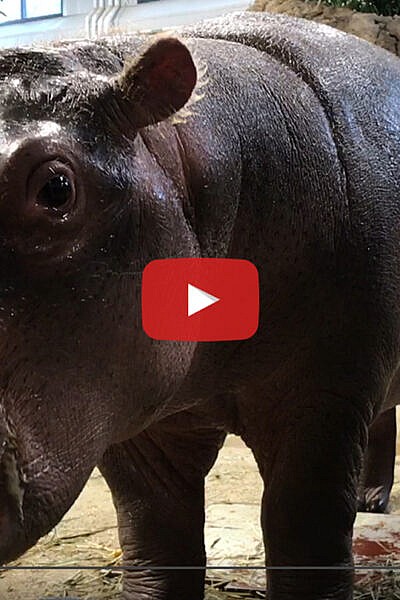

Our little hippo calf, Omo, is 9 months old, and he’s outgrown the baby-proofing in his indoor training area! He’s nursing less and eating more solid foods, which are helping him grow up big and strong. He recently weighed in at 435 pounds. That may seem huge to us, but Omo is still just a baby. He lives full-time with his mom, Zambezi, and has been learning to communicate with his aunt, Kasai, and dad, Biko, who live separately in the same habitat, by making little ‘chuffing’ noises. Keepers have seen Omo’s personality continue to get bigger, along with the rest of him. They say he doesn’t just enter a room; he explodes into it. Check in with Omo, his mom, Zambezi, and Water’s Edge: Africa lead keeper, Philip, in this video update.
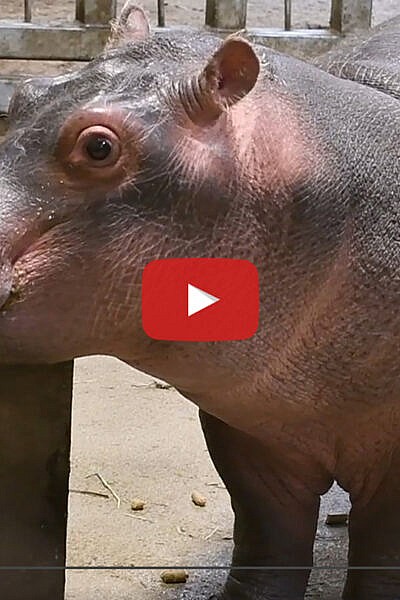

Get up close for a big lettuce crunch with Omo, CMZoo’s 8-month-old Nile hippo calf. Water’s Edge: Africa lead keeper, Philip, gives us an update on Omo’s latest milestones, including his first steps toward training and more explorations throughout his home.
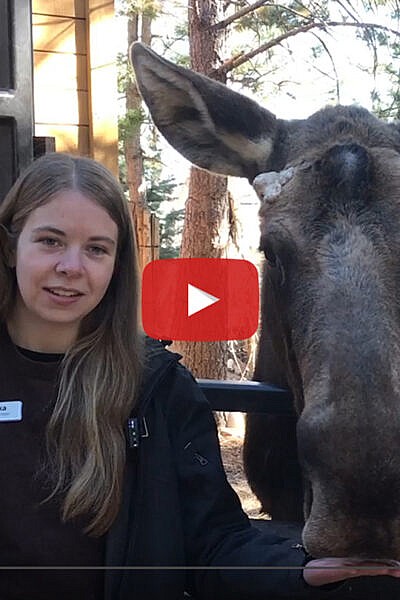

Join Atka for training! Our one-year-old Alaska moose has been busy learning new husbandry behaviors that allow his Rocky Mountain Wild team to care for him and his unique needs. Get a keepers’ eye view of hoof care and injection training with Atka, while his primary trainer, Erika, explains why and how they incorporated these behaviors into Atka’s care plan.
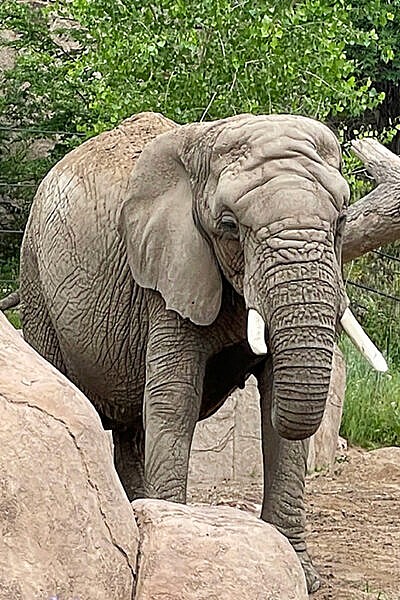

At the end of February, Malaika, one of six aging female African elephants at Cheyenne Mountain Zoo, was experiencing increasing mobility issues and severe changes in her appetite. After a few days of close monitoring and treatments to help her symptoms, she started to bounce back and has since continued to trend in the right direction. Although her team is happy to see her improve, they’re realistic, because Malaika – like all of the elephants at CMZoo – will have challenges for the rest of her life. Malaika has a lifelong issue with bowing and lack of strength in right rear leg, which is worsening as she ages.

“Some people are surprised to hear that our elephants deal with some kind of ailment, from time to time, but that’s why they’re here with us,” said Jason Bredahl, Encounter Africa animal care manager. “Our elephant center was designed specifically to care for aging female elephants and to help them with physical challenges as they age. Our keepers and veterinary staff are some of the most knowledgeable elephant experts in the profession. With our experience and the support of our colleagues, our Golden Girls are in great hands here. They’re living their best lives with us.”
Malaika is one of six “Golden Girls” in Encounter Africa, along with Missy, Kimba, Lucky, Jambo and LouLou. They’re all African elephants, but have unique personalities and some distinguishable physical features that help CMZoo visitors recognize and enjoy their individual personalities.
At 52, Missy is one of the oldest African elephants in human care in accredited zoos. She’s often in the yard with LouLou, 39, who is the easiest elephant to identify because she doesn’t have tusks. Kimba, 44, and Jambo, 39, are the largest of the group, weighing around 8,500 pounds each. Lucky, 43, is an enthusiastic mud wallower, and can be seen covering herself with mud in the yards. Malaika, 36, is one of the sassiest in the herd, who frequently carries logs, tires and puzzle feeders. She usually prefers to spend solo time in one of their many exhibit spaces at the Zoo, but hangs out with Kimba and Lucky for social time, too.
Just like humans, the health of each elephant is individual, sometimes regardless of age or environment. Malaika, the youngest of the herd, has experienced perhaps the most life-threatening issues and Missy, the eldest, has been in relatively good health for her age. The elephant care team works to help them comfortably enjoy their golden years, knowing that things can change quickly for them and that even our specialized care has its limits.
“There’s quite a range in their ages, and it’s not necessarily true that the older elephants need more specialized care than their younger friends do,” said Bredahl. “Over time, some have experienced weak limbs or digestive issues, some have arthritis, some have issues with their feet or tusks, and some have all of the above. We work to proactively lessen the impact of expected age-related issues and address anything else that pops up along the way.”
The dedicated Encounter Africa keepers, along with Bredahl, know these elephants like members of their own family. They work so closely with the ladies that they can usually ‘just tell’ if something is off, based on knowing each elephant’s individual behaviors and routines.

“We develop the skills to read their individual behaviors and know their patterns and tendencies,” said Bredahl. “We definitely have bonds with them and can usually tell what kind of a day they’re having based on their responses to training or enrichment activities. The equipment in our elephant center allows us to provide specialized care for them, but our relationships with the elephants guide those care plans, too.”
The Wilgruen Elephant Center, in Encounter Africa, at CMZoo is like a retirement community for elder elephants in the zoo world. This team and environment provide the very best in aging elephant care. Elements of the specialized elephant center include rubberized flooring, natural substrate throughout most of the barn, surveillance that allows the team to check on the ladies overnight, and spaces with activities designed to keep them moving.
The team consistently monitors each elephant’s daily behaviors, too. The elephant care team assesses and documents each elephant every day, so they can spot any trends that need to be addressed. Keepers track each elephant’s appetite, their mobility and interest in training, for example, along with individual indicators that reveal progress or declines in specific ailments, like a stiff knee or ongoing digestive issue. The team reviews each elephant’s data regularly, and makes adjustments to their environment, treatments or routines with hopes to maintain their quality of life.
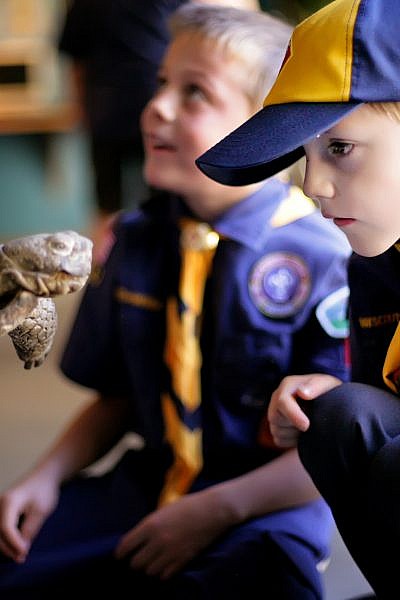

Cheyenne Mountain Zoo’s Saturdays for Scouts program offers opportunities to connect with nature and animals with a curriculum designed to help your scout earn a nature-themed badge.

A schedule-your-own option is available for both Boy Scout and Girl Scout groups. Email [email protected] to set up your customized program.
The Zoo has also just launched pre-scheduled sessions designed specifically for Daisy, Brownie or Junior Girl Scouts. Girls can sign up as groups or individuals for these two-hour workshops. The workshops will enhance participants’ relationships with Zoo animals and create stronger connections with nature. Opportunities for other scout organizations will be available this summer and fall.
Girl Scouts who participate in the spring workshops will get to connect with other Girl Scouts and establish relationships throughout their community of peers. These workshops are designed around nature-driven badge requirements and will give girls the opportunity to work together with a common goal.
10 a.m. to noon, Saturday, April 16, 2022 – Eco Learner Workshop – Daisy
Nature is all around us, and it is the gift that keeps on giving! Come learn how we can help nature stay beautiful through the exploration and appreciation of local flora and fauna. We will even meet an animal ambassador who lives right in our own backyard!
10 a.m. to noon, Saturday, April 23, 2022 – Bugs Workshop – Brownies
Did you know that bugs are super important to the world around us? Join us as we explore the giant world of bugs, meet bugs up close, and find out why they play an important role for our entire planet.
10 a.m. to noon, Saturday, May 7, 2022 – Animal Habitats – Juniors
What makes a good habitat for a wild animal? How do we protect the animal habitats around us? Have you ever made a habitat for an animal? Journey with us as we discover what wild animals need in their wild places. Then practice making the perfect animal habitat of your own for one of our smallest Zoo creatures.
- To register for an upcoming workshop for a Daisy, Brownie or Junior Girl Scout, visit https://www.cmzoo.org/events-programs/camps-classes/saturday-for-scouts/.
- To schedule your own Saturdays for Scouts session, visit https://www.cmzoo.org/events-programs/camps-classes/saturday-for-scouts/.
Advance registration is required. Please register at least one week in advance. Registration includes admission to CMZoo for the day.
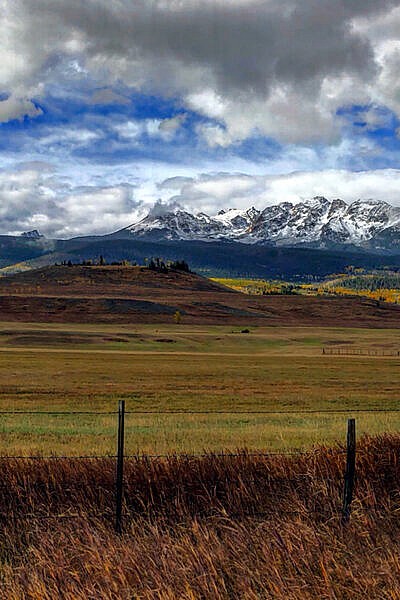

It’s springtime in the Centennial State, which means nature lovers from all over the world are making plans to explore Colorado’s beautiful wild places. Part of planning your adventure can include planning ways to take pride in every step you take.

“Exploring the great outdoors can be incredibly fulfilling, and as much as we benefit from exploring those places, there are ways we can show our gratitude for them while we enjoy them,” said Carrie Supino, Primate World keeper who is an avid conservationist and outdoorsperson.
Give it a thumbs up! If you see wildlife, a great way to tell if you’re giving it enough space is by holding your thumb up at arm’s length in your line of sight of the animal. Can you still see the animal around the outline of your thumb? Back up and enjoy that magnificent creature from farther away.
“Giving animals space keeps us and the animals safe,” said Supino. “Plus, if you keep your distance, you’re more likely to witness natural behaviors and you usually get more time to observe it.”
Make it a ‘trash-ure’ hunt. Leaving only footsteps is a great way to respect the outdoors, but what if you took it to the next level by gathering others’ (hopefully) accidental leave-behinds?
“I like to bring an empty peanut butter jar on hikes and fill it up with any trash I see,” said Supino. “The plastic jar is light, so you’re not adding much weight to your pack. Plus, if you come across anything stinky, just close that jar up tight and you’ll forget it’s there until you trash or recycle it later.”
Note the coordinates. Making memories with loved ones is even more special when you’re surrounded by the magic of nature. We want to etch those moments in time forever. Instead of leaving a mark on a tree or rock, use a GPS mobile app to note your exact coordinates. Imagine how much fun it will be to return to the exact location years later to re-discover it just as you saw it for the first time.

Tap into your inner artist. It’s only natural to want to bring a piece of a special place home with you, but a rock or wildflower in your pocket can’t do its job protecting a root system or feeding a bee. Bring a small notebook on your exploration, and take time to sit and truly observe the place you want to take home. Describe or sketch what you hear, see, smell and feel. Chances are, you’ll notice even more beautiful details, and instead of having just one piece of that place, you can use your imagination to relive that scene anytime.
“I love getting to my destination, but I really encourage people to stop and let the magnificence sink in,” said Supino. “Give yourself permission to stop and be quiet. You’ll see things you didn’t know were there.”
Trust the experts. Many destinations now require advance permits that limit the number of people on trails or at landmarks. This effort helps preserve the health of the location and the enjoyable experience for visitors. Destinations often share specific guidance that can help you protect the place you’re visiting, too. Check out the website, take the experts’ advice, and plan ahead for your next adventure.
“Making small changes can add up to a huge difference for our delicate ecosystems,” said Supino. “Whether you’re one of the Rockies’ 90 million annual visitors or you live here, consider how you can take pride in every step you take, knowing you’re protecting the future of Colorado’s great outdoors.”
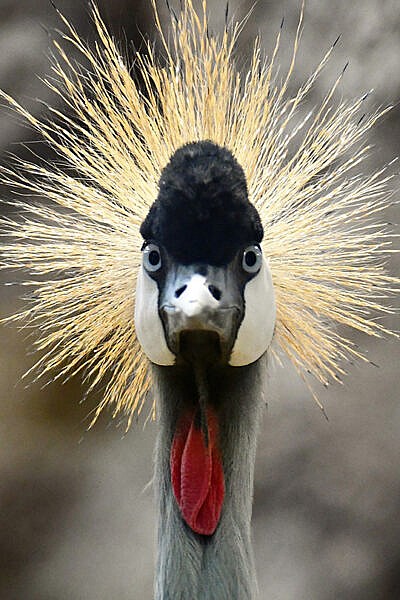

In its third consecutive year of Cheyenne Mountain Zoo members’ support, International Crane Foundation’s work to save crowned cranes in East Africa is gaining momentum. The project, based in Kenya, is critical in understanding why wild crowned crane populations have declined by more than 80 percent in 25 years.

“We have to learn why something is happening before we can intelligently change that course,” said Philip Waugh, lead keeper in Water’s Edge: Africa. Waugh, along with his team, cares for Inzi and Tagi, CMZoo’s two East African crowned cranes. He first championed this conservation project in March 2020. “I hope our members know what a huge impact they’re making for these incredible birds. This research wouldn’t be possible without our members.”
A vital element of the project, led by International Crane Foundation (ICF), in partnership with Endangered Wildlife Trust, is identifying individual cranes. The team locates crane nests, and once the fledglings are born, they apply a combination of color-coded bands to the chicks’ legs. Then the researchers track them as they grow up and compare data to see why some populations survive and others don’t.
Thanks to knowledge gained since beginning this project in 2020, ICF now believes there is a significant gap in the number of juvenile birds surviving to adulthood. Cranes seem to hatch and fledge at a healthy rate, but far fewer than expected make it to mature adulthood. Identifying what threats these juvenile birds face, and helping them survive to breeding age, could be the key to saving this species.
“Once a crane reaches maturity, its plumage doesn’t change, and there are no obvious visual indications of age,” said Waugh. “We could think we see a healthy flock of cranes, but they could all be well beyond breeding age. We need to know why one population of cranes is living into its late twenties, while another population isn’t surviving to adulthood.”
Each colored band on a bird’s leg tells an important piece of its story. One band indicates its country of origin, another defines where it was banded, and another specifies when it was born. We will learn a lot about which waterways the cranes depend on, how many offspring each crane typically contributes to a population, how they prefer to roost and their movement patterns.

The team is covering a lot of ground, and learning a lot about crowned cranes. In 2020, the team banded 48 chicks. In 2021, they banded 79. In the last year, they also banded a clutch of four chicks. Most crowned cranes lay 1-2 eggs per clutch. There are fewer than ten records of a group of eggs this large ever documented in Kenya. More great news, all four chicks in that family survived and were banded! Researchers also observed the first-ever recorded instance of East African (also known as Grey) crowned cranes nesting in a tree.
“They’ve been wanting to start this fieldwork for more than a decade, so when they learned our members could potentially support it, they were excited and so were we,” said Waugh. “It’s inspiring to see how ICF and our members have prioritized this project. It goes to show that just by being a member at CMZoo, you can make big impacts for conservation around the world. Our members have allowed an organization with a presence on multiple continents to focus a lot of energy on this one project.”
A vital piece of any conservation success is local community support. In their recent report, ICF said they have been encouraged by local support for the banding project. Community members have been helping conservationists by reporting sightings of the birds. They attribute this positive community response to increased community engagement.
Every membership and every visit to CMZoo are conservation in action. Since 2015, the Member Conservation Vote has provided $525,000 of membership revenue to support field conservation worldwide. Each year, a total of $100,000 of membership revenue is contributed to conservation in two ways:
- $25,000 to the Quarters for Conservation program, which in total contributes half a million dollars on average annually to CMZoo’s legacy conservation partners
- $75,000 to projects voted for by CMZoo members through the annual vote
Last week, CMZoo members voted to decide how each of seven nominated conservation projects will be funded in 2022, including a continuation of this effort to save East African crowned cranes. Stay tuned for the results, coming soon!
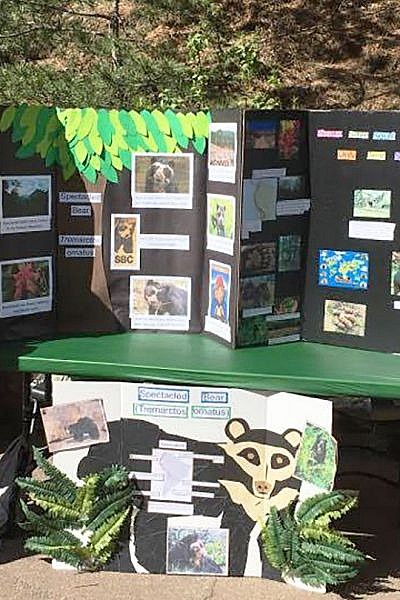

Zoos play a pivotal role in the care and conservation of the world’s most vulnerable species. From the largest land mammals, like giraffe and elephants, to the smallest jungle dwellers, like tree frogs and insects, species all over the world are regularly facing challenges that can threaten their future. The best tools to protect these species are education and sharing knowledge. Cheyenne Mountain Zoo has an event that equips our young visitors (and adults!) with this power in a fun and engaging way.

Endangered Species Day is a Zoo-wide event, geared towards other school groups’ participation, on Friday, April 15. They day-long event features 25 interactive stations led by 7th graders from Cheyenne Mountain Junior High School. Homeschool groups, scout troops, and preschools have all attended in previous years.
The 7th grade presenters have spent months researching endangered species and the conservation actions in place to protect them. The stations will feature student-made posters with powerful information and visuals, as well as interactive games, activities, and demonstrations that engage Zoo guests in captivating ways. These students are passionate and excited about sharing their knowledge and inspiring others to care for these species.
Though the day is geared towards other school groups’ participation, other groups can participate! We even encourage small groups, like parents and their kids, to register to attend Endangered Species Day.

You must register in advance as a group for CMZoo’s Endangered Species Day to receive a passport that aligns with the stations throughout the Zoo. As participants interact with the stations, their passports will receive a stamp. After visiting all 25 stations, and the passport is full of stamps, participants will be equipped with new knowledge and actions to better protect wildlife and wild places. Endangered Species Day registration includes admission to the Zoo for that day. To register and learn more about Endangered Species Day, visit cmzoo.org/ESD.
Members and zoo guests who are not affiliated with a group may also reserve daytime admission to the Zoo on April 15, and interact with the stations as a supplemental part of a regular Zoo visit. Advance daytime admission tickets are required. Tickets are available at cmzoo.org/visit.